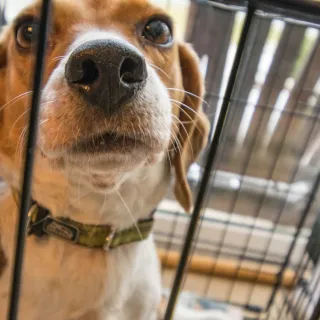Is Your Dog Distracting You As You Drive? Here's What to Do
Editor's Note: This is a guest post on the Grey Matters Blog and not written by anyone affiliated with Grey Muzzle. We allow guest contributors from time to time in order to provide our supporters with a wide range of topics pertaining to senior dogs.
You’ve likely seen enough terrifying stats, commercials, and warnings about texting while driving that you broke that habit and now drive hands-free. What about other distractions, though? While it may be fun to have your dog entertain you as you drive, it’s unsafe for you, your pet, and the other drivers on the road. There’s even a proposed bill that could make it illegal for you to pet your dog while driving. Whether it becomes the law or not, it highlights the importance of practicing safer driving when your dog is in tow.
The Realities of Distracted Driving
Distracted driving isn’t limited to using your phone or searching for something in the back seat. You can also be distracted by a passenger, especially if that passenger is also your pet who you’re responsible for. Distracted driving has serious consequences: In 2016, it took 3,450 lives. Even if you’re lucky enough to survive an accident, you or your pet could have lasting pain and medical bills.
It’s important to know what to do if you get into an accident, but wouldn’t you rather prevent it from happening in the first place? Keeping your dog safe while driving isn’t about ignoring him or withholding love. It’s about getting to your destination without any injuries or mishaps, which is an even greater sign of how much you care for him.
How to Keep Your Dog Safe
Your dog may not love the rules you’re about to set, but keeping everyone safe should be your top priority.
- Never drive with your dog on your lap. Not only is it distracting for you, especially if he starts squirming around, but if you stop short, he could knock into the steering wheel and get hurt. Stopping short can result in head or neck trauma, according to Dr. Richard Livingston from the Acoma Animal Clinic.
- No matter how small your dog is, he should travel in the back of the car. If your dog is riding in the passenger seat or in your lap and you get into a collision, the airbag can deploy and injure him.
- It’s safest if your dog sits or lays down in the back of the car, either on the seat or on the floor. Use a harness or a crate to keep him from moving around too much. The impact of a large dog on a passenger could cause a fatality if the crash is severe enough.
- Older dogs need extra support, especially when traveling, so you’ll want to buy orthopedic foam to use as bedding in the back seat.
- Roll the windows up at least two-thirds of the way. Your dog may love to put his head out the window and feel the wind on his ears, but if you hit the brakes even lightly, he could catch his neck or throat on the window or even be thrown from the car.
- If it’s very hot or sunny out, use window shades to keep your dog comfortably cool. Air conditioning doesn’t always reach the back of the car, so you’ll need additional ways to prevent heatstroke.
- Remove other driving distractions. Even if you’re not focusing your dog, doing something like using your cell phone could pose a risk. There are car safety apps that tackle this problem by blocking usage once it detects that your car is in motion.
How to Keep Your Dog Calm and Happy
Traveling in a car can be exciting or stressful for your dog, which means his energy will be up and it’ll be hard for him to relax. Here are a few ways to keep him calm:
- Bring along your dog’s favorite blanket and toys so he feels more at home in your car. This is especially true for older dogs, who need to be surrounded by familiar items.
- When you’re going on a long drive, it’s important to stop every hour and let your dog out of the car for a few minutes. Your dog will be able to run around a bit, drink water, and relieve himself. There’s an exception to this, though: If you’re traveling with an older dog, pick up on his cues to determine when he needs food or rest. You don’t want to wake up an older dog just to force him to get out of the car.
- If your dog is prone to vomiting when you drive with him, talk to your vet about medication. Not only is it distracting for you if your dog throws up while you're driving, but it can also become dangerous if he chokes on it.
Final Thoughts
Distracted driving can have results that aren’t as severe as injury but that still matter. For example, if you’re paying attention to your dog and end up swerving into another lane, going through a red light, or stopping for too long at a green light, you could get pulled over by a cop and be fined. With time, your dog will learn the new routine and know what to expect when he gets in the car, and you’ll find that you’re more focused on the road.
Devin roams the Pacific Northwest, bringing his dog, Scrummy, whenever possible. He is a strong believer that nothing can compare to a dog's unconditional love.
You can follow him and Scrummy on Twitter.



